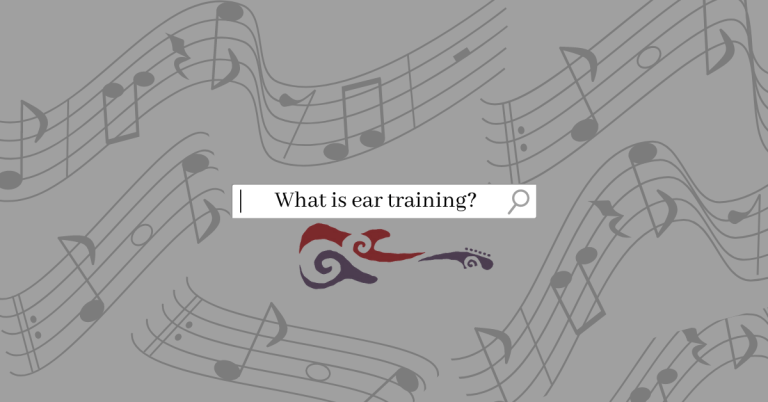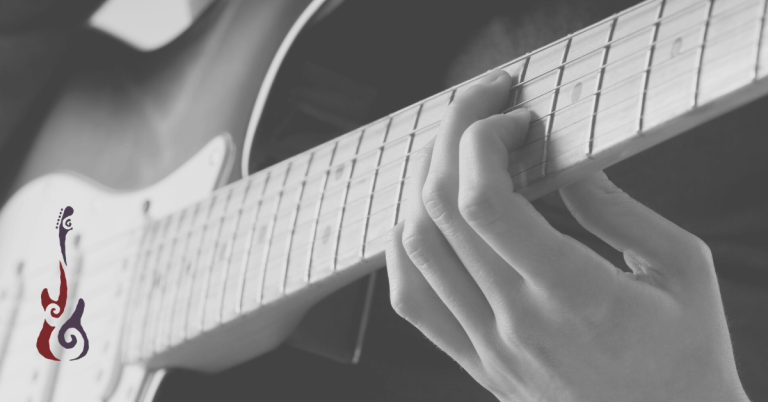Understanding the ii-V-I Jazz Chord Progression
This blog will explore the magic and sophistication behind the ii-V-I progression—the most common jazz chord progression. We will delve into jazz’s rich harmony and examine how this chord progression plays a vital role in shaping the unique sound of jazz. This topic can be mystifying for many beginning guitar players, so let’s unpack it.
Music Theory Basics
No matter if you’re an aspiring guitarist looking to broaden your musical horizons or a passionate music lover eager to explore the enchanting sounds of jazz music, you can enrich the experience by gaining the knowledge needed to navigate the vast world of jazz harmony.
What are chord progressions?
At the core of jazz music lie chord progressions—sequences of chords that establish the harmonic framework for a piece. Chord progressions provide the foundation upon which melodies are built, and improvisation takes flight. They are like the canvas on which jazz musicians paint their musical expressions. “Jazz chords” create tension, resolution, and emotional depth, giving jazz its distinct character and complexity.
What is jazz harmony?
Unlike traditional classical harmony, jazz harmony embraces extended and altered chords, intricate voicings, and chord substitutions. Jazz harmony emphasizes the use of tensions, such as the 9th, 11th, and 13th, which add richness and complexity to the chords. Additionally, jazz musicians often employ improvisation, voice leading, and reharmonization techniques to further explore and enhance the harmonic possibilities within a chord progression.
The ii-V-I Progression: The Backbone of Jazz
The ii-V-I progression stands as one of the most foundational and ubiquitous chord progressions in jazz music. Understanding its structure and variations is essential for any jazz guitarist seeking to navigate the rich harmonic landscape of this genre.
What is the ii-V-I progression?
The ii-V-I progression is a three-chord sequence commonly found in jazz standards. It consists of:
- A minor 7th chord built on the second degree of the major scale (ii)
- A dominant 7th chord built on the fifth degree of the major scale (V)
- A major 7th chord built on the tonic of the major scale (I)
For example, the ii-V-I progression would be Dm7-G7-Cmaj7 in the key of C major.
Some common jazz guitar voicings
To apply the ii-V-I progression on the guitar, it’s important to familiarize yourself with practical chord voicings. Traditional voicings such as the root position and drop 2 voicings provide a solid foundation. Learning different inversions, shell voicings, and spread voicings will expand your harmonic vocabulary and offer more options for creating interesting and compelling jazz chord progressions.
Mastering the ii-V-I progression is crucial for any jazz guitarist as it unlocks a world of possibilities for improvisation, composition, and understanding the harmonic language of jazz. By exploring variations, substitutions, and practical chord voicings, you will enhance your playing skills and gain the confidence to navigate jazz standards fluently and creatively. Embrace the ii-V-I progression as your guidepost, and let it propel your guitar playing to new heights of musical expression.
Knowledge by Numbers
In every major key, there are seven chords. Regardless of which key we are in, the quality (major, minor, diminished) and the order in which they occur will never change.
Here’s an example in the key of C major: C, Dm, Em, F, G, Am, Bdim
As mentioned, the quality and order of these chords won’t change, so they are not exclusive to any given key, so we can begin to represent them as numbers rather than specific chords symbols:
1, 2m, 3m, 4, 5, 6m, 7dim
Now, let’s switch to the commonly used format of Roman Numerals:
I, ii, iii, IV, V, vi, viidim
So a 2m, 5, 1 (also written as ii, V, I) in the key of C major is created with the following chords: Dm, G, C.
Let’s do another one in the key of G — Am, D, G. Easy, right?
In the Beginning: Scales, Arpeggios, and More Scales
The ii-V-I jazz chord progression occurs frequently. Within its unique cadence lies a hidden world of harmony for us to explore. Remember, learning music requires practice and patience, but it’s well worth the effort.
Here are some ideas for familiarizing yourself with jazz harmony and improvisation:
If the three chords in question are all derived from the same scale, you could run up and down that parent scale for a solo or create a melody, and that would certainly work—this is sometimes called “playing above the changes.” However, there is a different, more interesting approach—it’s called playing “inside the changes.”
The idea is to use the notes in the scale deliberately and with intention; instead of just playing the C major scale up and down, use the notes of any given chord at that moment (arpeggios).
Once you’ve mastered the parent scale and arpeggios, you can begin experimenting with scales other than the C major scale and its modes. For example, try playing the G whole tone scale or the G half-whole diminished over the V chord. An endless array of new sounds is possible, so open your ears and dig in!






